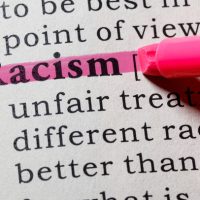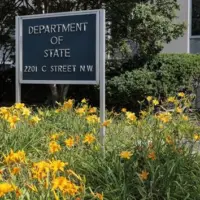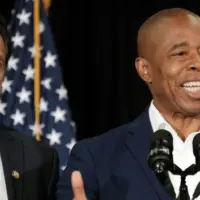
 Devonyu/iStock(WASHINGTON) — The terms “racist”, “white supremacist” and “white nationalism” have re-entered into the mainstream political conversations as a rising number of 2020 Democratic presidential candidates and lawmakers accuse President Donald Trump of using divisive identity politics, recent high profile violent acts and as law enforcement say crimes linked to white supremacy are on the rise.
Devonyu/iStock(WASHINGTON) — The terms “racist”, “white supremacist” and “white nationalism” have re-entered into the mainstream political conversations as a rising number of 2020 Democratic presidential candidates and lawmakers accuse President Donald Trump of using divisive identity politics, recent high profile violent acts and as law enforcement say crimes linked to white supremacy are on the rise.
Sen. Bernie Sanders said after the mass shootings El Paso and Dayton that Trump is a “racist” who is seeking to appeal to “white nationalist.” So far, at least seven Democratic presidential contenders have escalated their criticism of Trump and his racist rhetoric, calling him a “white supremacist” outright.
Trump has denied being a white supremacist, repeatedly calling himself ” the least racist person.”
Experts say that amid the heated rhetoric of race, such inflammatory terms are often being incorrectly used interchangeably. Using the terms so broadly and generally can actually be harmful in that it desensitizes and normalizes what should–by most measures– be considered abhorrent behavior, said Terrence Johnson, an associate professor of religion and politics at Georgetown University.
Law enforcement agencies are especially troubled and on alert when they notice self identified white nationalists active on websites and social media identified with hate groups and see it as a warning sign that violent acts might follow.
Here’s what you need to know.
What does it mean to be a racist?
The Merriam-Webster dictionary defines racism as “a belief that race is the primary determinant of human traits and capacities and that racial differences produce an inherent superiority of a particular race.”
“A racist is someone who simply uses, I would say ordinary language and ordinary habits, to basically justify why they hate whoever the other is whether it is black, or the other is an immigrant or the other is a gay, and they use ordinary language to talk about difference as inferior,” Johnson said.
“Racists don’t necessarily have the ideology of a white supremacy, but what they do have is a certain kind of bigotry towards other races based on characteristics of race,” said Marilyn Mayo, a director of Anti-Defamation League’s Center on Extremism.
What is white supremacy?
The Merriam-Webster dictionary defines a white supremacist as “a person who believes that the white race is inherently superior to other races and that white people should have control over people of other races.”
The essential difference between a racist and a white supremacist is that supremacists have an actual ideology, Mayo said.
“A racist is not always a white supremacist or white nationalist, but a white supremacist is always a racist,” John Cohen, a former senior Department of Homeland Security official and current ABC News contributor said.
Some of the key tenets of white supremacy according to the Anti-Defamation League, an international Jewish non-governmental organization focused on exposing extremism beliefs, are that white people of European descent are genetically superior to other non-white people, that their own “culture” is superior to other cultures and that the white race is in danger of extinction due to a rising “flood” or “invasion” of non-whites.
White supremacy as a concept has been around since the founding of America and dates back prior to and with the rise of slavery and the genocide of Native American groups in this country, Johnson said.
“As we look at the slave trade and European exploration, we see over and over again this idea that, whether its in the so called ‘orient’ or it’s in Africa, we keep hearing words like barbarian, uncivilized, lack of religion, grotesque,” Johnson said. “These terms really make up the overall framework for how white supremacy is defined as a nothing of Europeans seeing non-Europeans as inferior, intellectually, morally and aesthetically.”
What is white nationalism
The Merriam-Webster dictionary defines white nationalism as “one of a group of militant whites who espouse white supremacy and advocate enforced racial segregation.”
The first major signs of the phrase “white nationalism” appear in the early 1970s, according to Mayo. “The Turner Diaries,” a white-nationalist fantasy novel published in 1978 by William Luther Pierce, told the story of an armed uprising against the federal government by defenders of the white race.
Even though it’s a different name, many experts believe that white nationalism is being deliberately used as a euphemism for white supremacy — a trend that has increased over the last 10 years in a concerted effort to soften and mainstream white supremacists’ image in the public sphere.
“Generally, a lot of folks within this movement will say that they’re white nationalists and not white supremacist. They don’t like that term anymore,” Mayo said. “Their ultimate goal is to reach disaffected whites and bring them into the movement and white supremacy just isn’t going to cut it to do that.”
According to experts, leaders within the white supremacy movement recognized that their views were being seen as too fringe, so they decided to re-brand themselves as white nationalists instead in an effort to tap into the mainstream political rhetoric.
“It’s because there’s been such a recoil against the concept of white supremacy and the elements of white supremacy that are central to their beliefs that they just came to the conclusion of calling it something different,” Cohen said. “We’re going to try and frame it as a legitimate, ideological viewpoint that is connected to a belief in your country opposed to a belief in your race.”
According to the site Stormfront.org, which purports to be a white nationalist organization of ” community of racial realists and idealists, white nationalists are a “community of racial realists and idealists.” They claim that white nationalist “support true diversity and a homeland for all peoples, including ours.”
The strategic re-branding of white supremacy is working in their favor according to Cohen.
“There are people who wouldn’t go out and commit an attack, but who are deciding how to vote based on the same rhetoric that’s being spread on white supremacist websites,” Cohen said.
How action separates a racist from a white supremacist
Action is an important aspect of the white supremacy doctrine according to experts.
“Racism is a belief maintained by an individual that may or may not influence behavior,” Cohen said. “But connected to what white supremacy is, it’s been used throughout our history to organize groups of people for action, whether it’s public displays through civil unrest in marches or actual acts of violence.” Cohen said.
In May, the FBI warned of the increasing threat of domestic terrorism, specifically saying that the number of the number of cases targeting white supremacists, white nationalists and other racially-motivated extremists has jumped in the past six months.
The white supremacist movement has been extremely effective in spreading its doctrine on the Internet which has allowed leaders in the movement the ability to organize people at a faster pace, experts said.
However, Cohen noted that also provides justification for those looking for an excuse to act violently.
“We’re seeing an increase in violence by those who are inspired by or are using white supremacy as the justification for their act of violence, but it’s not because these groups are going out and recruiting people, training them and deploying them,” Cohen said. “It’s because more people have access to their hateful ideology and rhetoric online, and it’s resonating with them. And for those in our society who are angry and seeking something to justify the use of violence it’s there.”
Assistant Director of FBI’s counterterrorism division Michael McGarrity testified to a House panel in May echoing the same sentiments, warning that that the hatred and extremist ideology are increasingly being spread online, and “that mobilization to violence is much quicker” than it used to be.
Labeling is tricky and should not be done lightly
Johnson argued that while there is definitely a threat of white supremacy in the United States and abroad, that there is a risk de-legitimizing the harmful impact of white supremacy if it isn’t used properly.
Mayo agreed, saying that she has seen the term used to describe people who are exhibiting signs of racism, but not necessarily supremacist or nationalist viewpoints of organizing and action.
“We need to look at someone’s ideology is, how they’re promoting that ideology, how they’re contextualizing it and what their end goal is,” Mayo said. “When we’re trying to define someone as a white supremacist, we’re not only going to look at the words that they say, but also what their actions are.”
Copyright © 2019, ABC Radio. All rights reserved.















